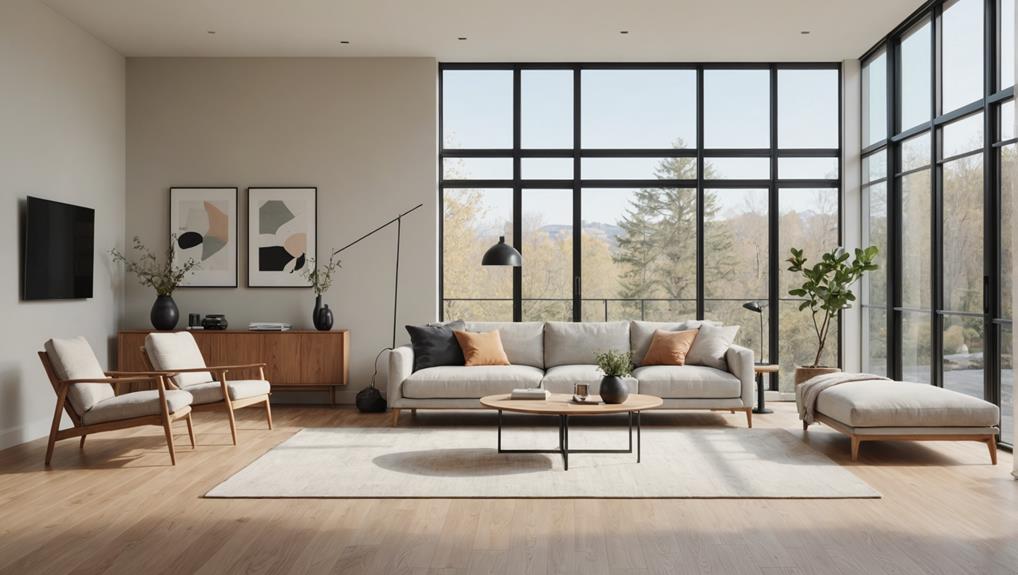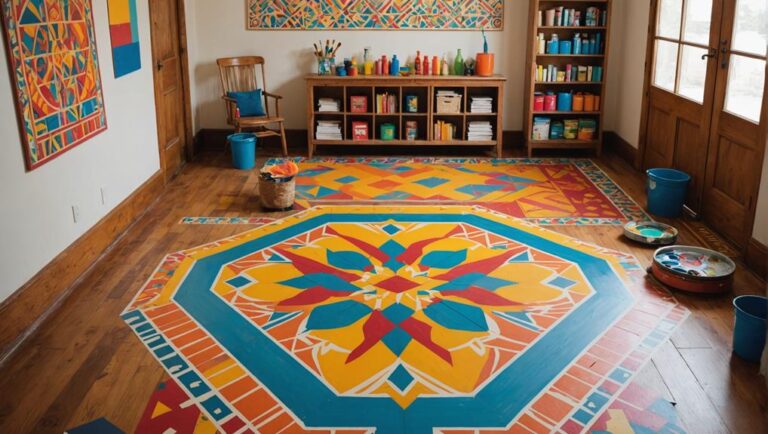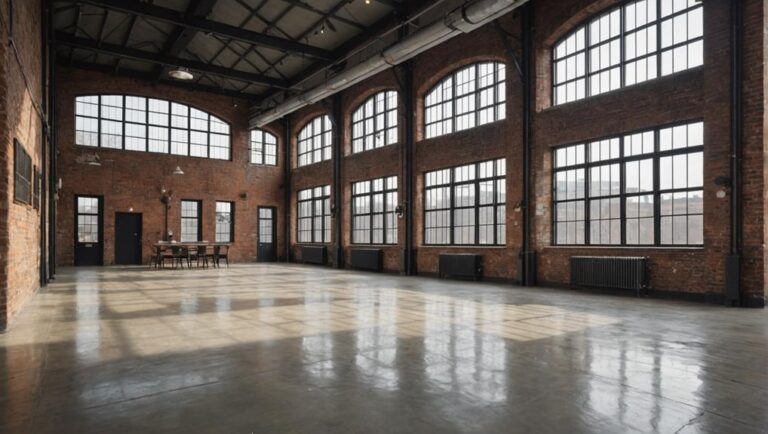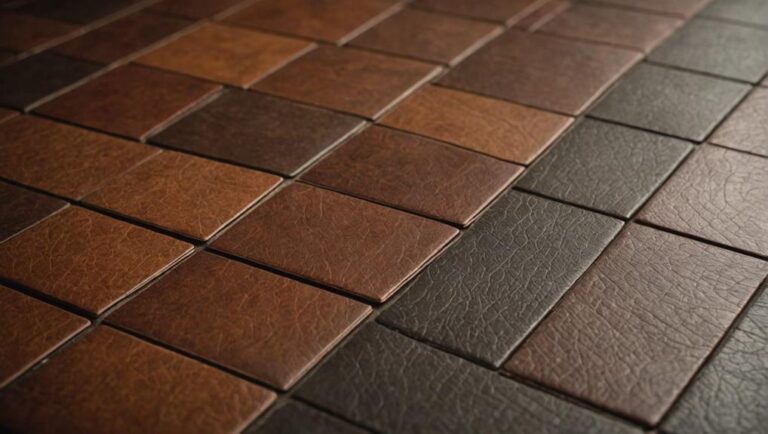Choosing the right flooring colors can truly open up your space. Light shades like soft grays or creamy beiges reflect more light, creating an airy ambiance that tricks the eye into seeing a larger room. Harmonizing tones, along with subtle textures, enhance this effect while adding visual interest. Patterns also play a key role; stripes or larger tiles can elongate and widen perceptions of space effectively. Consider how natural light impacts your choices, too. By mastering these elements, your home can feel more expansive and inviting. There's so much more to explore in achieving that perfect illusion of space.
Understanding Color Psychology
When you step into a room, the colors beneath your feet can profoundly influence your mood and perception. Imagine walking on a warm, sandy beige; it wraps you in a sense of comfort and calm, making you feel at home. Alternatively, a deep, rich navy can evoke feelings of serenity, but it might also create a slight heaviness in the atmosphere. Understanding color psychology is vital when choosing flooring, as the emotional impact of colors can greatly enhance your space.
Color associations play an important role in how you and your guests feel while in a room. For instance, vibrant reds can inject energy and excitement, but they may also feel a bit overwhelming if overused. Soft greens, on the other hand, are often linked to nature and tranquility, providing a fresh, rejuvenating vibe.
Think about how these colors interact with your furnishings and decor. A light gray floor can expand the space visually, promoting a sense of openness, while darker hues can create an intimate setting. The key is to balance your flooring choices with your desired emotional experience.
As you contemplate the colors beneath your feet, remember that they can shape not just the room's aesthetic but also your overall sense of safety and well-being. Choose wisely, and let the colors guide you toward a space that resonates with your heart and mind.
Benefits of Lighter Shades
Choosing lighter shades for your flooring can transform a space in remarkable ways. Imagine stepping into a room where the floors reflect light beautifully, creating an airy ambiance that instantly makes the area feel more open. Lighter floors enhance light reflection, allowing natural sunlight to bounce around, which not only brightens the room but also contributes to a sense of warmth and comfort.
The impact of lighter shades on spatial perception is equally significant. When you choose a soft beige, pale gray, or a gentle cream, you're effectively tricking the eye into perceiving a larger space. These hues create a seamless flow, minimizing the visual weight that darker colors often carry. This subtle illusion can be particularly beneficial in smaller rooms, making them feel more inviting and less cramped.
Safety is another important aspect to contemplate. Lighter flooring can help illuminate any potential hazards, making it easier for you and your family to navigate. Whether it's a spill or a toy left on the floor, the increased visibility offered by lighter shades can prevent accidents.
Choosing the Right Tone
The allure of lighter flooring shades opens up a world of possibilities when it comes to selecting the perfect tone for your space. When you're choosing flooring, consider how tone harmony plays a pivotal role in creating a cohesive environment. A soft, muted hue can enhance natural light, making your room feel more expansive and inviting. Imagine a pale oak that not only reflects sunlight but also complements your wall colors seamlessly.
However, don't shy away from exploring shade contrast. A slightly darker tone in your flooring can define areas without overwhelming them, especially when paired with lighter furniture or decor. For instance, a warm beige floor can provide a stunning backdrop for white furniture, striking a balance between comfort and style. This contrast can draw the eye upward, creating an illusion of height in your room.
When selecting the right tone, think about the feeling you want to evoke. Cooler shades, like light gray, can impart a modern and sophisticated vibe, while warmer tones can bring about a sense of coziness and warmth. Always keep in mind the safety of your environment. Choose non-toxic finishes and materials that offer durability along with aesthetic appeal.
Ultimately, finding that perfect balance of tone harmony and shade contrast will guarantee your flooring not only enhances the spaciousness of your rooms but also creates a safe, welcoming atmosphere you'll love coming home to.
Patterns That Enhance Space
How can patterns transform your space into an enchanting haven? The right flooring patterns can create an illusion of spaciousness, making your rooms feel larger and more inviting. Striped patterns, for instance, can draw the eye along the length of a room, effectively elongating its appearance. If you opt for bold, horizontal stripes, they can even enhance the sense of width, while vertical stripes add height.
Incorporating geometric designs adds a modern touch and can also play tricks on the eyes. Large tiles with minimal patterns can provide a seamless look, reducing visual clutter. When laid in diagonal layouts, these tiles create a dynamic flow that can make any area appear more expansive.
Here's a quick overview of flooring patterns that enhance space:
| Pattern Type | Effect on Space |
|---|---|
| Striped Patterns | Elongates and widens rooms |
| Geometric Designs | Adds modern flair; depth |
| Large Tiles | Seamless, uncluttered look |
| Diagonal Layouts | Creates dynamic flow |
When you choose patterns, remember that less can often be more. Minimal patterns can prevent overwhelming the senses, allowing for a serene atmosphere. By leveraging these optical illusions, you can transform your home into a safe haven that feels more spacious and inviting.
Flooring Materials and Effects
When choosing flooring, the interplay between light and dark shades can dramatically transform your space. Light colors can create an airy, expansive feel, while darker tones add depth and coziness. Plus, the texture and patterns of the materials you select can influence not just the look, but also the atmosphere of your home.
Light vs. Dark Shades
Often, homeowners find themselves torn between light and dark shades when selecting flooring materials, each choice bringing its own unique ambiance and practical effects. Light shades can enhance room perception by creating a sense of openness and brightness, while dark shades evoke warmth and intimacy, often producing dark illusions that can make spaces feel cozier yet smaller.
When considering your options, think about these factors:
- Light Effects: Bright hues can reflect natural light, enhancing spatial awareness.
- Dark Illusions: Deep colors can create a grounded atmosphere but might visually shrink a room.
- Color Contrasts: Pairing light and dark shades can achieve striking design balance.
- Shade Combinations: Mixing shades can add depth and intrigue, fostering aesthetic harmony.
- Safety Considerations: Lighter floors may show dirt less, while darker options can hide scuffs.
Ultimately, it's about finding the right balance that complements your design vision. The interplay of light and dark can dramatically affect how you perceive your space, so choose wisely to create the atmosphere you desire.
Texture and Pattern Influence
Texture and pattern play an essential role in shaping the overall aesthetic and functionality of your flooring choices. When you select materials, consider how texture contrast can create visual interest while enhancing safety. For example, a smooth, polished surface paired with a textured rug can help delineate spaces and prevent slips. This balance not only adds dimension but also promotes a sense of spaciousness.
Pattern scale is equally important. Larger patterns can make a room feel more expansive, while smaller patterns might make it cozy but can also potentially overwhelm a small area. Think about how the scale of your flooring patterns interacts with existing furniture and decor; it's all about harmony.
If you choose planks or tiles, varying their orientation can also influence how your space feels. For instance, laying tiles diagonally can draw the eye and create an illusion of a larger area.
Ultimately, selecting the right textures and patterns isn't just about aesthetics; it's about creating a safe and inviting environment. You want your flooring choices to reflect your style while ensuring the comfort and safety of everyone in your home.
Transitioning Between Rooms
When you're moving from one room to another, the flooring can create a sense of continuity or disruption. By choosing a consistent color palette and employing seamless material changes, you can enhance the visual flow throughout your space. Imagine how a well-planned shift can guide the eye and unify your home's design!
Consistent Color Palette
Creating a consistent color palette as you shift between rooms can greatly enhance the flow and cohesion of your home. By choosing colors that work well together, you create a sense of color harmony that makes your space feel larger and more inviting. It's all about maintaining a cohesive design that links each room seamlessly.
Here are some tips to help you achieve this:
- Choose a base color: Start with a neutral shade for the main flooring to establish a foundation.
- Select accent colors: Pick one or two complementary colors for accents in rugs or decor to add depth.
- Consider room function: Think about how the colors can enhance the purpose of each room; calm tones for bedrooms and brighter hues for living spaces.
- Use textures: Different textures can add interest without overwhelming the color palette.
- Test samples: Always try out flooring samples in your space to see how colors interact with natural light.
Seamless Material Transitions
Shifting between rooms can be a delicate process, especially when it comes to flooring materials. You want your home to feel cohesive and inviting, and that starts with your material choices. Opting for seamless blends between different areas can enhance design continuity, giving each space a natural flow.
When moving between rooms, consider using transition techniques that prioritize color harmony. For instance, if you've chosen light hardwood in one room, a similar-toned tile in the next can create a pleasing visual cohesion. This approach not only elevates flooring aesthetics but also improves spatial perception, making your rooms appear larger than they are.
Additionally, think about how different materials can interact. A soft carpet can shift beautifully into sleek vinyl, provided they share a common color palette. This not only adds safety by minimizing tripping hazards but also maintains a sense of unity. By carefully selecting your flooring materials and focusing on smooth shifts, you can transform your home into a haven of comfort and style, where each room feels connected yet distinct. Remember, the right choices will make all the difference in how your spaces come together.
Visual Flow Techniques
Achieving a seamless visual flow between rooms can truly transform your home's ambiance. By creating visual continuity, you enhance spatial perception, making your spaces feel more expansive and inviting. Here are some techniques to guarantee that your flooring choices guide the eye effortlessly from one room to the next:
- Consistent Color Palette: Choose shades that harmonize across rooms, allowing for a cohesive look.
- Similar Materials: Use the same type of flooring, like hardwood or tile, to maintain a unified style.
- Strategic Area Rugs: Place rugs that complement both adjoining rooms, linking them visually without obstructing flow.
- Connecting Spaces: Incorporate small transitions, like a hallway, to introduce a slight change without disrupting continuity.
- Lighting Considerations: Use similar light fixtures to create a sense of unity, enhancing the perception of space.
Natural Light Considerations
When considering your home's flooring colors, the interplay of natural light plays a significant role in how those hues will ultimately appear. Sunlight angles can dramatically alter the perception of your chosen colors, adding depth or washing them out depending on the time of day. Imagine how morning light gently warms a soft beige, making it feel inviting, while the afternoon sun might cast a cooler tone, leaving it looking stark.
To maximize the effect of natural light, think about using reflective surfaces in your flooring. Glossy finishes or lighter shades can capture and bounce light around the room, creating an illusion of spaciousness and brightness. If you opt for darker colors, be mindful of how they absorb light, which can make a room feel more confined.
Consider the layout of your space too. Rooms that receive ample sunlight can handle bolder colors, while those with limited light might benefit from lighter hues that reflect whatever natural light they get. It's essential to test your flooring samples in various lighting conditions throughout the day before making a final decision.
Ultimately, by being mindful of how natural light interacts with your flooring choices, you can create a home that feels larger, airier, and more welcoming, ensuring that every corner exudes warmth and safety. Embrace the power of light—it can transform not just your floors, but the entire atmosphere of your home.
Practical Tips for Selection
As you commence on the journey of selecting flooring colors, it's crucial to keep in mind that every choice you make can greatly influence the overall feel of your space. A well-chosen flooring color can create the illusion of larger room proportions, making your home feel more open and inviting. Here are some practical tips to guide you in your selection:
- Choose Light Colors: Light shades, such as soft whites, creams, or pastels, reflect more light and can enhance the perception of space.
- Consider Color Combinations: Pairing your flooring with complementary wall colors can create a seamless shift, making your rooms feel expansive.
- Use Consistent Flooring: Keeping the same flooring throughout your space can eliminate visual breaks, contributing to a more cohesive and larger feel.
- Test Samples: Always bring home samples and see how they look in your natural light. This helps you understand how color combinations work together throughout the day.
- Think About Texture: Opt for smooth finishes that reflect light or subtle textures that add depth without overwhelming the space.
Frequently Asked Questions
What Are the Best Flooring Colors for Small Bathrooms?
When you're picking flooring colors for small bathrooms, light colors are your best bet. They can instantly brighten the space, making it feel more open. Consider shades like soft whites, pale grays, or light beiges. Incorporating reflective surfaces, like glossy tiles or vinyl, enhances this effect, bouncing light around and creating an airy atmosphere. You'll not only achieve a visually larger space, but also maintain a safe and inviting environment for everyone.
Can Dark Flooring Make a Room Feel Cozy Instead of Cramped?
Absolutely, dark flooring can create a cozy atmosphere instead of feeling cramped. When you opt for rich, dark tones, they bring a sense of visual warmth that wraps around you, making the space inviting. Pairing these hues with soft lighting and warm textures enhances that snug feeling, turning your room into a comforting retreat. Just be mindful to balance with lighter elements to guarantee the space feels open and welcoming, not overwhelming.
How Do Different Flooring Materials Affect Color Perception?
Different flooring materials can greatly affect color perception through their texture and finish. For instance, smooth surfaces like polished tiles reflect light, enhancing vibrant hues and creating a sense of spaciousness. In contrast, textured materials absorb light, muting colors and evoking warmth. Understanding color psychology helps you choose wisely—light colors can uplift, while darker shades may provide comfort. Ultimately, the right combination of material texture and color can transform your space into a safe haven.
Should I Match My Flooring Color With My Furniture?
When you think about matching your flooring color with your furniture, the choices can feel like an endless ocean of possibilities! Striking the right balance between furniture contrast and flooring trends is key. If your furniture's bold and vibrant, consider a more neutral floor to let it shine. Conversely, if your furniture's subtle, a rich floor can add depth. Ultimately, you want a cohesive look that feels safe and inviting for everyone.
How Often Should I Change My Flooring Color for a Fresh Look?
You should consider changing your flooring color every five to seven years to keep up with flooring trends and refresh your space. Color psychology suggests that lighter shades can create a sense of calm and openness, while darker hues can add warmth. If you're feeling adventurous, try experimenting with trendy colors that reflect your personality. Just make sure whatever you choose maintains a safe, inviting environment for you and your loved ones.




